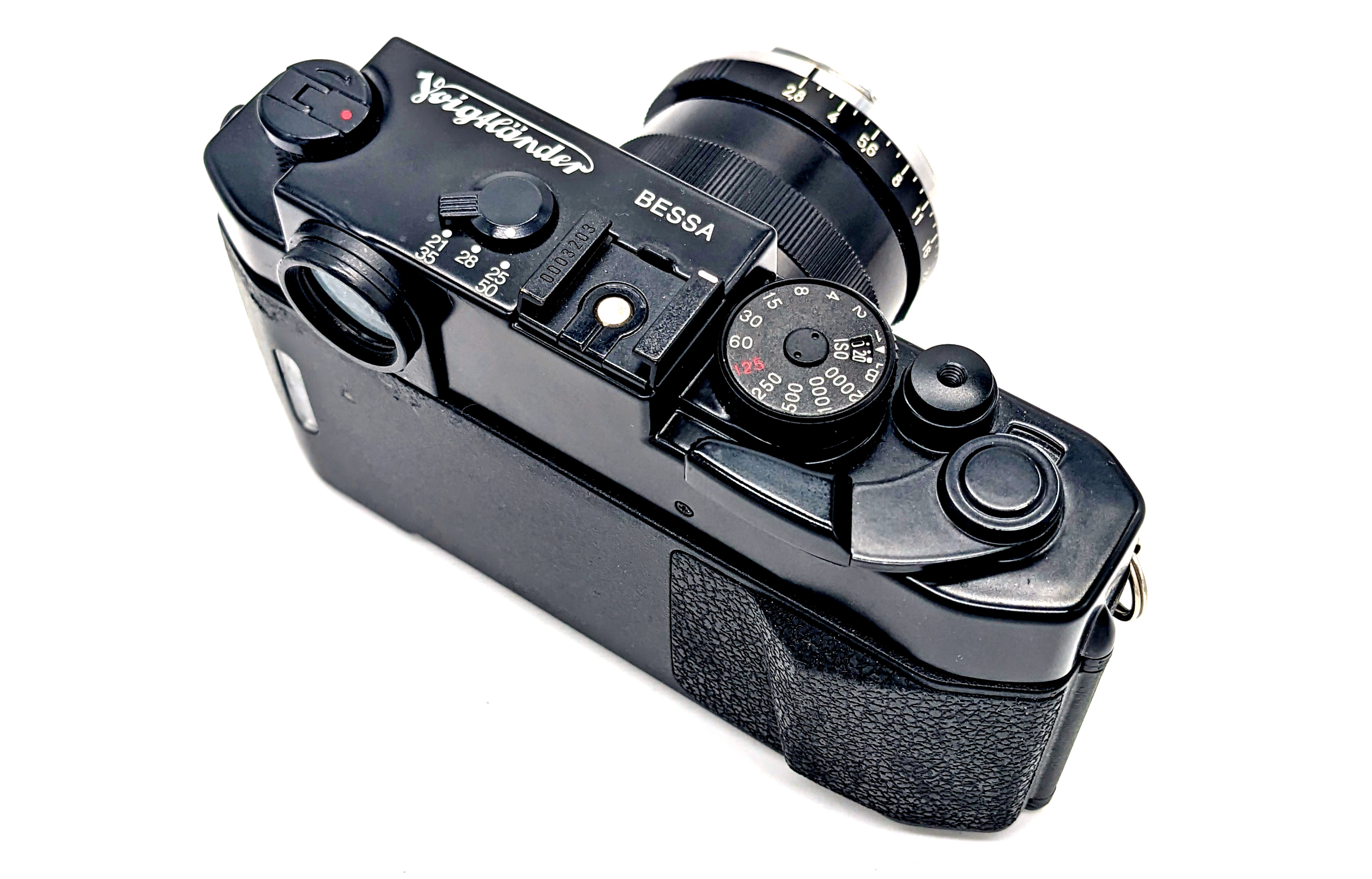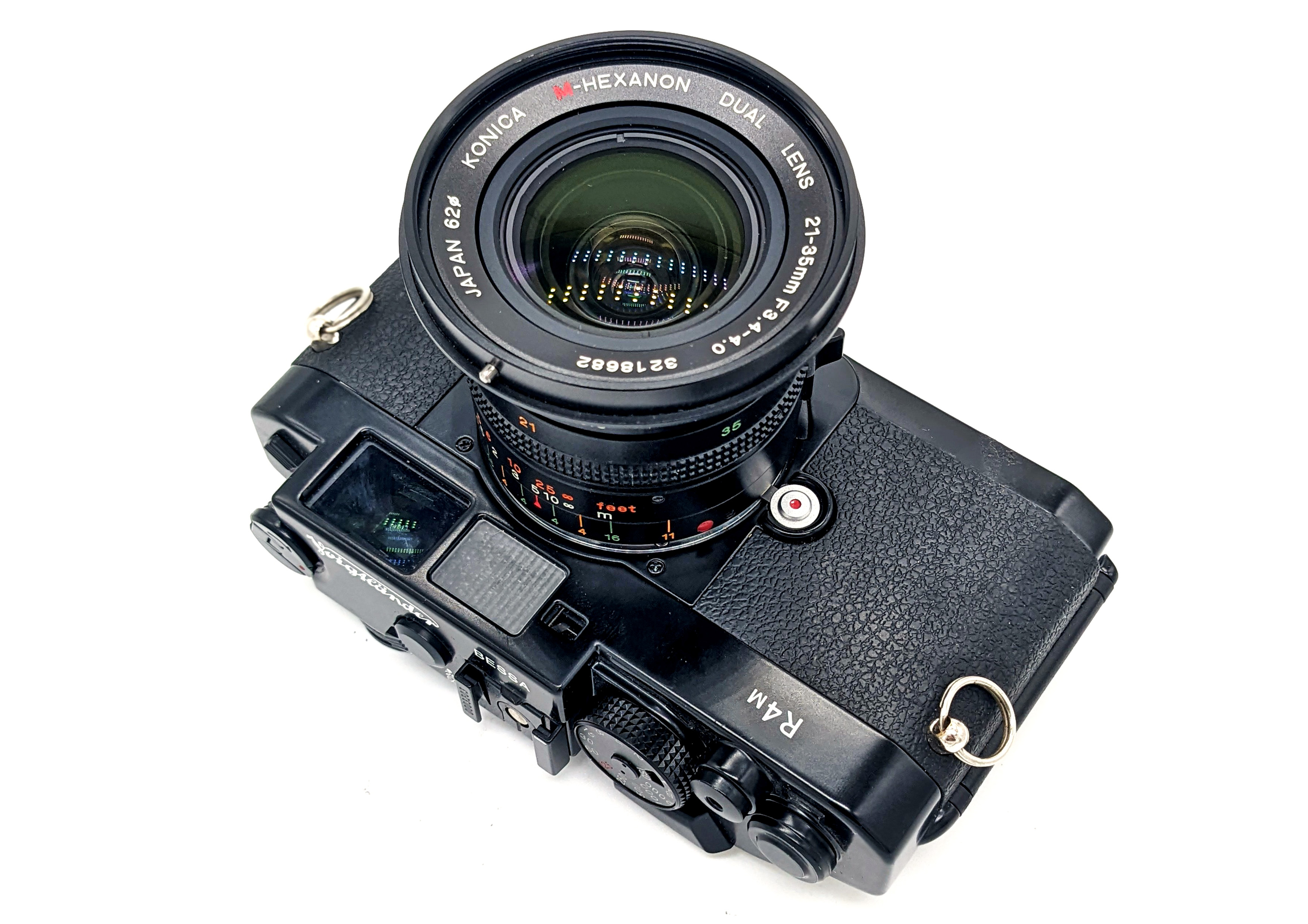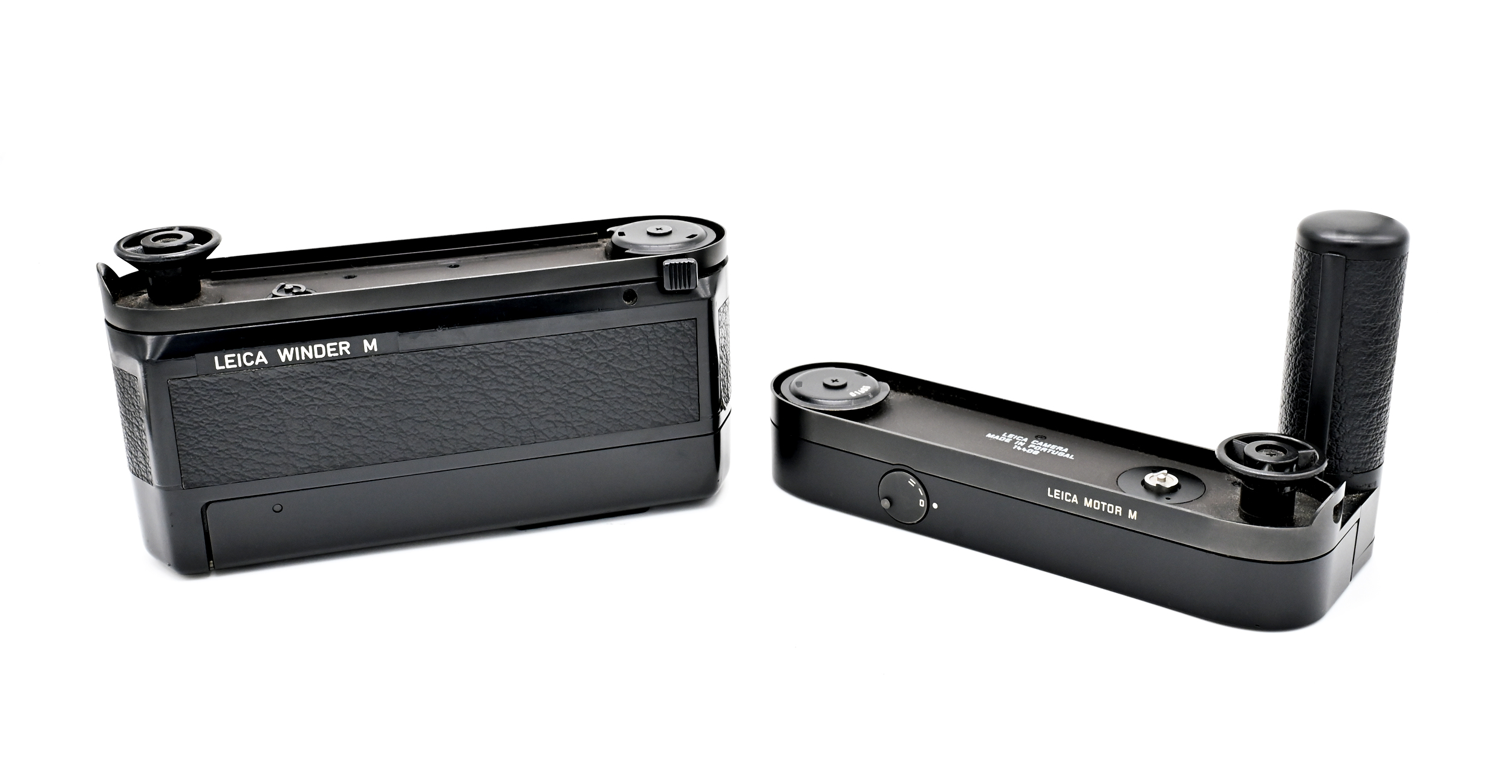
There is nothing quite like detachable motor drives for 35mm cameras. By the 1970s, external motor drives were being offered by all major SLR manufacturers. For instance, the 1973 MD-2 motor drive for the Nikon F2 could achieve 5 frames per second and could automatically rewind the film. Even for consumer-level SLRs, the major manufacturers offered cheaper drives that could achieve 1.5 – 3 frames per second. By 1984, the Canon F-1 had a special edition motor drive that could achieve 14 frames per second. At the absolute top of the best-looking motor drive pyramid was the MD-4 for the Nikon F3HP.
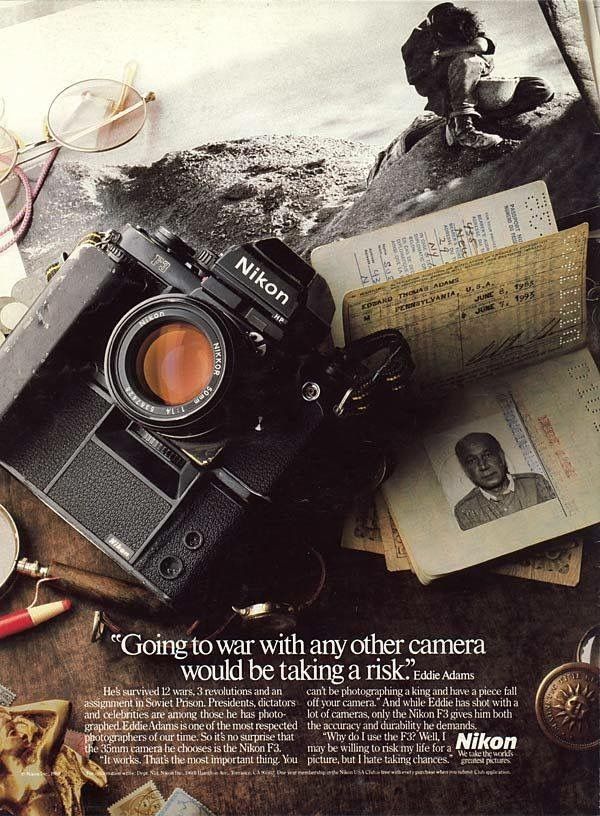
The Leica Motor Drives
Before 1976, there had been two options for rapid film advance for its M cameras. The first was the 1960-66 “Leicavit,” a very limited production bottom trigger advance that only fit on the Leica M1, M2, MD, and the original MP. According to Cameraquest, only 2,000 to 3,000 of these units were produced. The second option was the custom “New York Motor Drive” developed privately by famous camera guru Norman Goldberg. In 1965, Leica purchased all of the designs and tooling from Mr. Goldberg to produce the motor drive for special versions of the M2 and M4 (the “M2-M” and the “M4-Motor“). Model “14000” was a pretty unique, but massive unit. The bottom of the drive had a switch that permitted up to 3 frames per second for speeds 1/50 to 1/1000 and a 1 frame per second mode for operation down to 1 second. Needless to say, both of these units today are hopelessly expensive collectors’ items.
In 1976, Leica introduced the “M4-2 Winder” (Model 14214) contemporaneously with the Leica M4-2. It really only worked on the M4-2 and not on earlier or later cameras. Many on the internet have reported that the M4-2 Winder just has too much torque for any M camera and perhaps should just be relegated to the camera shelf of history. For the adventurous, there is a write up for pros-only about how to re-calibrate the M4-2 Winder for less torque. Leica later introduced a slightly different M4-P Winder, but it is similarly not too desired.
In 1987, Leica introduced the “Winder M” (Model 14403). The Winder M is basically the same unit at the previous M4-2 Winder but works with the M4-2, the M4-P, the M6. the M7, and the new MP. I would imagine that it also would work with the new M-A. The consensus is that the Winder M has less torque than its predecessor, so can be used safely with any M except for the M3 (due to its more fragile components) Leica suggests that one not activate the motor without film in the camera body.
In 2000, Leica replaced the “Winder M” with the “Motor M.” Although a much smaller unit, it retained the 3 frame per second capabilities and adds an actual integrated grip.
Starting in 1989, the late, world-famous Tom Abrahamsson designed and built about 3,000 high-quality trigger-operated “Rapidwinder.” In 2003, Leica began producing a new trigger-operated “Leicavit” for the M4-2, the M4-P, the M6, the M7, and the MP. These retail new for about $1,300 and advertise that “with practice,” you will be able to use your third hand to advance the film up to 2 frames per second. It appears that the Motor M has now been discontinued.
The Winder M (1987)
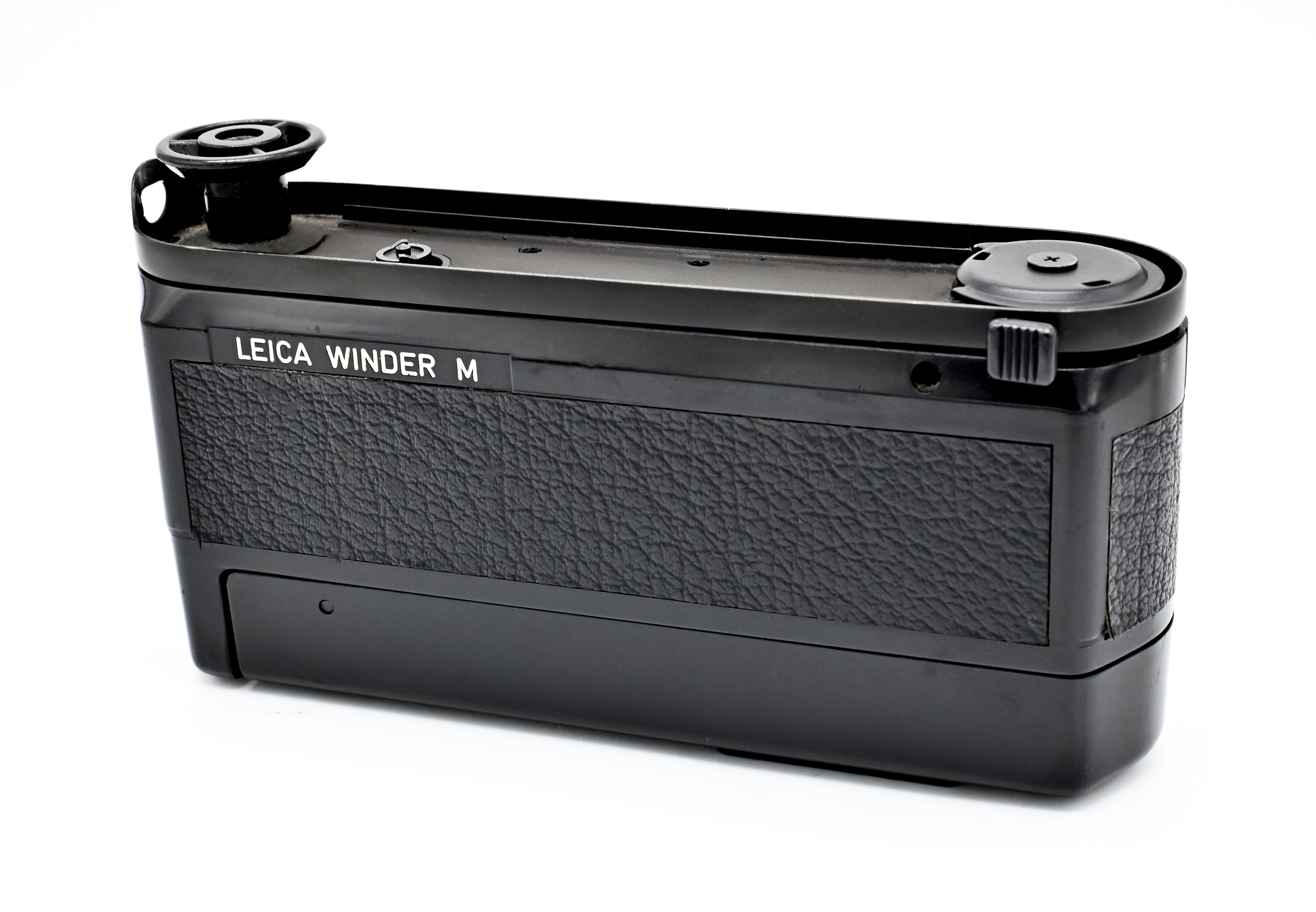
The entire idea of a “motor drive” is somewhat of an anathema to many Leica aficionados. For maybe good reasons? A motor drive on a Leica M (or any rangefinder camera) adds unnecessary weight, bulk, and noise for arguably minimal increased functionality. These motor drives cannot power the camera. They cannot rewind the film. They will never approach SLR-like performance. Secondary concerns revolve around how motor drives have the potential to damage internal camera components and how dead batteries can ruin your day.
For me, any of those concerns fall away when you realize that you can purchase a Winder M any day of the week for as little as $40. One cannot even buy a OEM Leica lens cap for $40. Does the Winder M deserve the condemnation and/or indifference it has received? Let’s check it out.
An initial aspect to note about the Winder M is that there are no electrical contacts between the body and the motor drive. The motor drive operates mechanically, advancing the film take-up until it encounters resistance when the camera is “wound” for the next shot, and then automatically trips itself “off.” For SLRs, the widespread advent of electronic shutters during the 1970s made it possible for the camera body to trigger an external winder electrically, which is a better system.
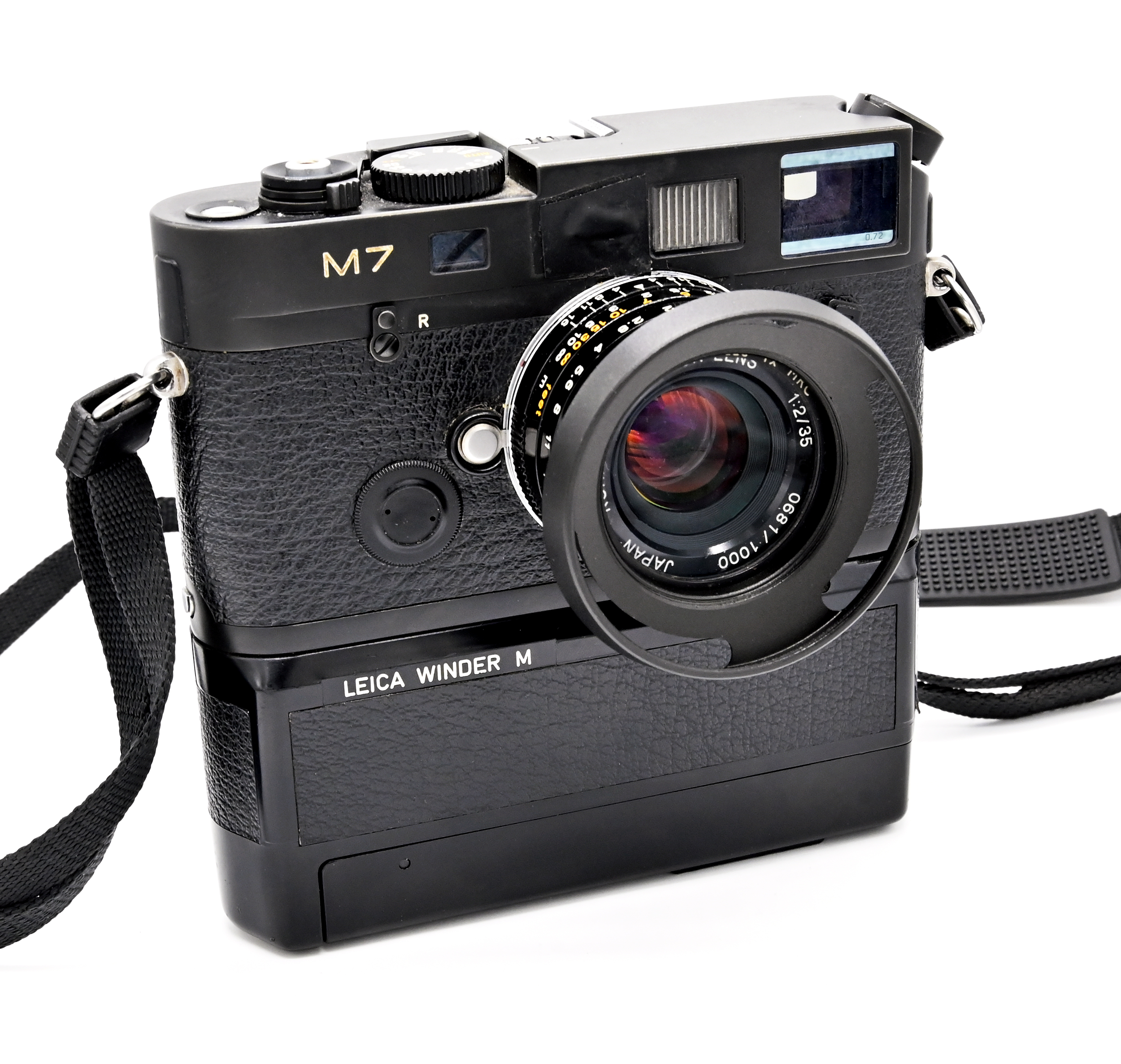
CHEAP: For some reason, the Winder Ms are among the cheapest OEM Leica M accessories available. With so many still in circulation, we can assume that the Winder M does not have many latent problems that would have killed these units over time.
Putting It On: Be sure that film is loaded and that you have fired the shutter. Pull the Winder lever all the way around the unit by pressing up on the lever. Take the bottom plate off your M and then replace with the Winder. Then turn the lever all the way around to the “On” position to lock and enable the unit. You are ready to go.
On/Off: Move the lever back from the “On” position and that will disengage the motor drive for regular, old-timey shooting. However, unless you want to remove the motor drive in the dark and replace the original camera baseplate, you are stuck with the drive until you finish your roll.
Shutter Feedback: When the motor advances, the shutter button will rebound a bit on your finger. Do not be alarmed.
Batteries: The Winder M takes 4 1.5V Alkaline AA batteries or any of their substitutes. These fit nicely into a little tray in the bottom part of the unit.

Noise: Is the Winder M especially noisy? I do not think so. Certainly quieter than 1970s-era external motor drives.
Leica M7 Exposure Lock Woes: Unfortunately, the M7’s exposure lock resets every time the film advances with a motor drive. Thus, if you have locked the exposure for shot number 1, the metering will reset as soon as the photo is taken. As explained below, this occurs with the newest Motor M as well. Most likely, Leica did not take this into account when designing the AE system on the M7.
Gripes About the Grip: The Winder M does not have an integrated grip. Although it would have been nice, holding the camera is not especially difficult without one.
Using the Winder M: This probably comes down to whether you enjoy using motor drives or not. Certainly, an idea use would be for tripod work. For left-eyed shooters (like me), you do not have to remove your eyes from the viewfinder to advance the film. It also removes a step from the photo-taking process so you can focus on getting the shot, especially when the scene is moving around you. You trade some inconspicuousness for some functionality. Nothing in life is free. Especially Leica stuff.
Motor M (2000)

The current Motor M is a much smaller and probably better designed motor drive than the Winder M. Although sharing the same theoretical maximum FPS rate, the Motor M is a little quieter, much smaller, has a handy grip, and actually has several mode selections It is compatible with the same stable of post Leica M4-2 cameras. Although the Motor M more or less coincided with the introduction of the new electronic-shutter M7, Leica decided that backwards compatibility was important than automation, i.e., Leica could have designed a motor drive that was electronically triggered, as opposed to manually. The Motor M essentially works in the same mechanical method as the Winder M.
NOT A TERRIBLE DEAL: Used Motor Ms appear to go as low as $300. Still a very cheap Leica accessory.
Putting It On: Unlike the Motor M, there is no “On” latch to rotate to lock the drive into place. Simply remove your M baseplate and slap the drive onto the base. The locking mechanism is the same as the standard baseplate.
Modes: The Motor M has three switch positions — Off / 1.5 FPS (quiet) / 3 FPS (louder). So you can turn the motor on and off at will. However, turning the motor drive off does not fully disengage the unit — so film advance smoothness is compromised. Word on the street is not to use continuous modes at less than 1/50 or the motor may advance before the shutter closes. Mr. Nemeth advises to not use “I” mode anyway for true continuous shots — only use “II.” I agree,
Shutter Feedback: Just like the Winder M, there is shutter recoil. No big deal.
Batteries: 2 x 123A Lithium batteries — they fit into the grip and are loaded through the bottom. Supposedly good for 100 rolls. Speaking of the grip, there have been reported problems with the grip portion popping out. It is easily noticed — so watch out for that if you buy a used one.
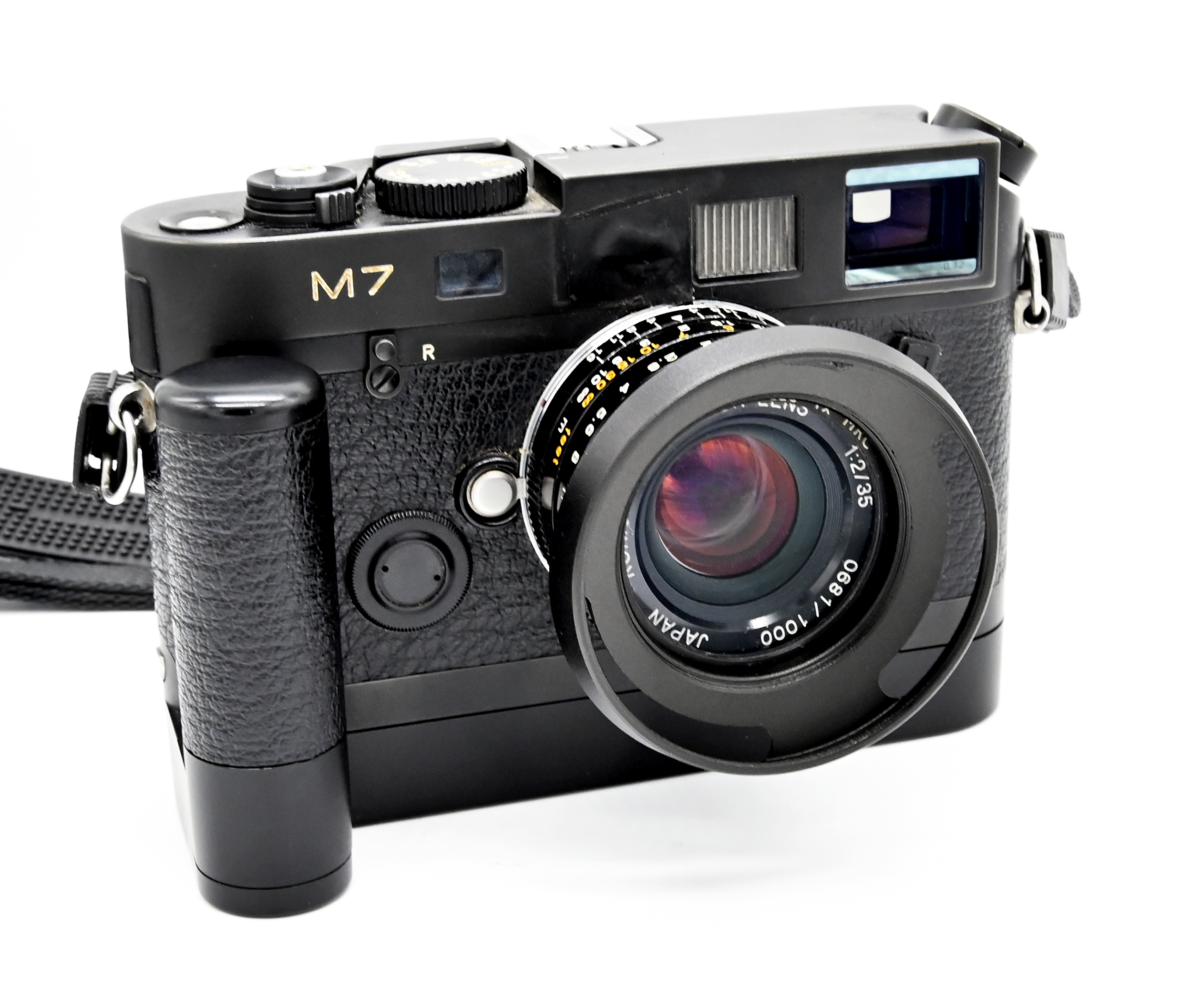
Noise: Do not expect the Motor M to be as quiet as a regular Leica shot. You will hear the click plus the whirl of the motor. “I” is supposed to be quieter than “II” — but in the real world, it’s pretty close. The Motor M is quieter than the Winder M, but they make different sounds.
Leica M7 Exposure Lock Woes: Just like the Winder M, the M7 will reset its exposure lock after each shutter activation.
Using the Motor M: The Motor M has a much lower profile than the Winder M and feels better integrated into the body. The grip allows better positioning for vertical photos. Although the performance is not impressive when compared to any modern SLR motor drive, the unit is small enough that the added weight (225g) is not going to bother you.
Conclusions
Leica did a fairly good job developing motor drives for cameras that were not designed for motor drives. Thank Mr. Goldberg who in the early 1960s conceived of the idea and made it work. Still, the Leica motor drives remain generally unpopular with the mainstream crowd as somewhat antithetical to the ethos of rangefinder photography. If these units were more expensive, I would tend to agree. However, with the Winder Ms being so cheap, it’s almost that you cannot afford not to own one if you use a M4-2, M4-P, M6, M7, or MP. It is definitely a different way to shoot with a rangefinder that takes a little getting used to. You probably will not hate it or think that the motor drive will alert everyone on the street to your presence. Think of it this way — if you only get one chance to capture the “decisive moment,” you can now multiply that chance by 1.5 to 3 times.
There are some advantages to either system. The Winder M: (1) takes easier to find and slightly cheaper AA batteries; and (2) is way cheaper (1/8 the price on the used market). The Motor M: (1) is quieter; (2) has built-in grip: (3) has three selectable modes; and (4) is newer model so in theory easier to get OEM service if something goes wrong. You will most likely not regret acquiring and using either one. If you shoot often, you will find situations where a motor drive will be useful.

